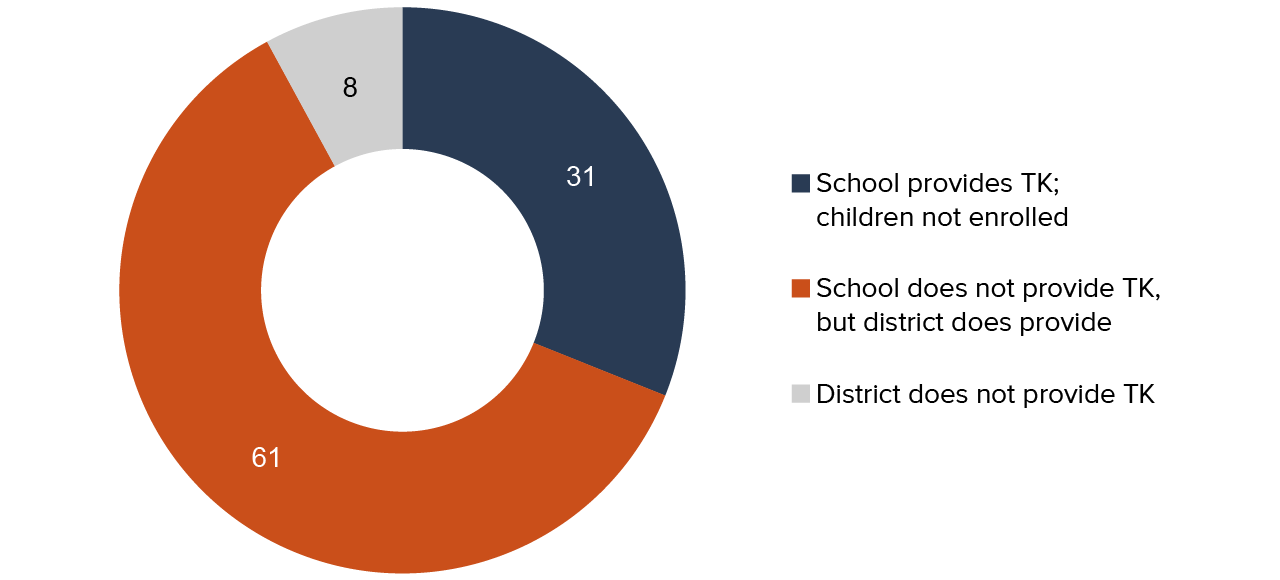In hopes of leveling the playing field for young children, California will expand Transitional Kindergarten (TK) to all four-year olds by fall 2025. Currently, about a quarter of four-year-olds are eligible for TK, which has been part of the state’s early learning programs since 2012.
Kindergarten students in California have some of the largest gaps in school readiness in the country—and greater access to high-quality early learning is a proven way to reduce these disparities. There are also long-term benefits: preschool graduates go on to experience increased rates of high school graduation and college enrollment, higher earnings, lower welfare use, and less contact with the criminal justice system than their peers.
Is Transitional Kindergarten Serving Students Equitably?
A key issue as the state moves toward universal TK is whether all students have sufficient opportunities to enroll in the current program—and how to improve equity going forward.
- Encouragingly, TK currently serves relatively high proportions of Dual Language Learners and Latino students. Students from low-income families also participate at about the same rate as the average student. Districts seem more likely to offer TK at schools serving higher percentages of Dual Language Learners and students from low-income families.
- However, Native American and Pacific Islander children appear to be consistently underenrolled, both due to a lack of TK in their districts and schools, and lower enrollment when it is offered. Black children are also somewhat underrepresented, particularly when they attend schools that offer the program.
- About 80% of eligible four-year-olds are enrolled in TK, including some younger children served through Expanded TK, a program that some districts opt to provide.
- There are roughly 41,000 unserved students under current eligibility rules. About six in ten reside in districts offering TK but in school zones that do not, nearly a third live in school zones where TK is already provided, and 8% live in districts that do not offer TK at all.
- Rural districts are less likely than other districts to offer TK at 80% or more of their schools. The same is true for “basic aid” districts, which are funded primarily through property taxes rather than the state funding formula.
Most unserved children attend a school that does not offer TK, even though their district offers TK

SOURCE: California Department of Education TK enrollment, 2019–20.
NOTES: TK Census Day counts. All schools serving kindergarten students, including charters, are included. See Figure 10 in the report for full notes.
How Can California Ensure Universal Access to TK?
Enrollment in Transitional Kindergarten is influenced by various factors, including family interest and the availability of other early learning and care programs. While families should choose the option that best suits their needs and preferences, our findings suggest that more can be done to ensure that all eligible children have access to TK. These steps include making sure that all districts and elementary schools provide TK, that schools have the resources to offer enough slots for interested families, and that the program is well advertised so families are informed about TK.
Specifically, we recommend the following:
- Monitor enrollment and provide targeted outreach to underrepresented families. Outreach may be particularly helpful in boosting low participation rates among Pacific Islander, Native American, and Black children. Educators and policymakers should strive to better understand the factors driving families’ choices to improve marketing and shape the program so that it can better meet families’ needs.
- Collect enrollment data on special education students in TK. Data from the California Department of Education does not include any way to assess whether special education students have equitable access to TK. We recommend including a special education indicator in the TK enrollment data. This information is essential to understanding whether the program is provided equitably for these students and whether they have the opportunity to reap the benefits of TK.
- Ensure that all schools offering kindergarten also provide TK. Expanding the program’s reach means that districts may need to increase the number of schools providing TK, increase the number of TK slots at schools, or both. Offering new TK programs at schools will likely present more challenges than growing existing classrooms.
- Provide more incentives for districts to provide TK. About 17% of districts serving kindergartners do not offer TK at all. These districts tend to be smaller, and about 28% of them are basic-aid districts, meaning there is no enforcement mechanism to ensure they provide TK. Other accountability measures, such as including TK provision in the California School Dashboard, could help encourage all districts that are not yet providing TK to do so.
- Support rural districts in reaching out to eligible families and expanding TK. Participation among Dual Language Learners and students from low-income families is somewhat lower in rural districts. To help these districts expand their TK offerings, policymakers may need to provide support to overcome challenges related to larger facilities, long distances, transportation, and staffing constraints.
Topics
K–12 Education Population Poverty & Inequality




